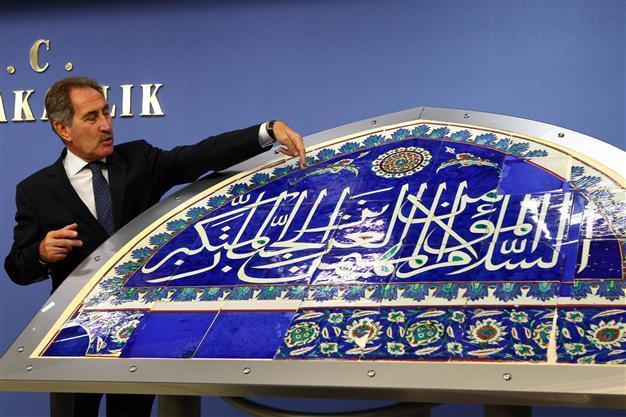Minister Günay has one more surprise of artifact
ANKARA - Anatolia News Agency

Culture Minister Ertuğrul Günay presents the stolen İznik tiles at a ceremony. AA Photo
Culture and Tourism Minister Ertuğrul Günay announced on Aug. 13 the return of stolen historical İznik tiles dating back to the 16th century, which had been stolen from Sinan Paşa Mosque in the northwestern province of Bursa a decade ago. Günay also told Anatolia news agency that he would give more good news about a significant Turkish artifact within a month. “This time it is not a sculpture or a tile, but a different thing,” he said.He said Turkey’s historical richness was endless but unfortunately its value had not been appreciated enough in the past, so Turkish cultural and historical artifacts had been taken abroad by two different methods.
“At the end of the 1800s, before we knew their historical value, foreigners and diplomats were given gravestones from the Roman, Byzantine or Ottoman and Seljuk periods, and they carried them to their country in their luggage. Then Europeans said, ‘Let’s conduct excavations, and let us take half of the artifacts we unearth.’ They took the best of the artifacts that they unearthed and left the rest in Turkey,” Günay said.
He said international regulations did not allow Turkey to request the return of those artifacts since those methods were legal. “But there are also artifacts that were openly stolen. They were put in suitcases and smuggled. There are depots for stolen artifacts at our customs gates. For instance, when you go to Edirne, you see that the artifacts seized at the customs gate almost fill a room. When we determine a smuggled artifact in a collection, auction house or museum abroad, we first demand its return, saying, ‘This is stolen. Give it to us first, and then we will collaborate with your museum. Otherwise, we will not maintain cultural and official relations with you, because it destroys our self respect.’”
Günay said there were many artifacts like those İznik tiles in the hands of Western museums and collectors, and said they had serious problems securing their return. “Many people of conscience support our campaign but unfortunately, some organizations, people, museums and collectors who have a wallet in the place of their conscience, form a group opposed to us,” Günay said.
He said he sometimes read articles criticizing this campaign in U.S., British or German magazines, but there were also those delivering artifacts to Turkey of their own accord. “There is a positive atmosphere that our campaign has created in Turkey and the world. When I go to Poland, Greece or a country in Asia Minor, they welcome our campaign with excitement because they have the same problem. We make new protocols for cooperation with the culture ministers of these countries.”
İznik tile puzzle
The minister said the İznik tiles had been stolen on three separate dates in 1998, 2001 and 2002. He said the tile pieces had arrived from the United Kingdom and all the pieces had been put together thanks to nonstop work done night and day.
Günay said he was very excited when one of his colleagues told him that he had found traces of the stolen tiles. “My colleague told me that he could undertake some financial responsibility for the return of the tiles but asked us to take responsibility to bring them to Turkey. With great pleasure, I closely followed the whole process. It was a bit of a detective process. In the end, I charged our culture and tourism consultant and he took them from a place three or four hours away from London. Since it was a stolen artifact, it had been stored in a place. They delivered it in two steel suitcases. We immediately got in touch with the ambassador and they provided us with a diplomatic bag. Our colleagues began waiting for the plane at the airport at 4 in the morning. When we opened the luggage, the pieces were like a puzzle.”
Günay said restoration experts from the Museum of Anatolian Civilizations, Ethnography Museum and Istanbul put the pieces together after a few days of working. “It is now on display at the Ankara Ethnography Museum. Maybe we will display it at the Turkish and Islamic Arts Museum later on. I’m also considering putting a replica in Bursa’s Yenişehir but the original ones should remain in the museum for better protection.” He also added that visitors to the museum would be given a certificate with the story and a photograph of the artifact.
Suppiluliuma replicas to be made as gift products

Günay also announced plans to make replicas of a Hittite sculpture of Suppiluliuma that was recently discovered in the eastern Turkish province of Hatay’s Reyhanlı district. He said the unusual features of the sculpture made it more precious. “Roman sculpture makes us very excited, but this is different. Works like this one can be found only in northern Mesopotamia and Asia Minor. It weighs 1.5 tons and is made of basalt stone.”
He said the sculpture had created a tremendous impact in the international media as well as in Turkey.
















